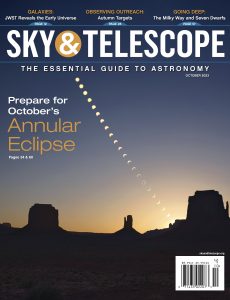
Sky & Telescope – October 2023
polski | 88 pages | pdf | 17 MB
SOLAR ECLIPSE TAKES VIEWERS on quite a ride. Whether it’s annular or total, an eclipse of the Sun offers arguably the most exquisite progression of dramatic changes to celestial objects that we can observe from Earth with the naked eye (with proper protection, of course).
Have a look at Fred Espenak’s striking composite of the 2005 annular eclipse on page 34. If you start in the upper left and work your way visually left to right and down each row to the lower right, you get a palpable sense of this exacting succession. As you eyeball each stage, vague references pop into mind: a chipped bowl, a bitten cracker, the Apple logo, a boomerang, and finally a golden wedding ring before “reversing” back to the chipped bowl.
Whatever allusions pop into your mind, what stands out most prominently for all of us in that series is the series itself. The same is true of Rick Fienberg’s arresting parade of images of the 2017 total eclipse on page 84. Given that witnessing the full run of any eclipse lasts several hours, taking in an entire eclipse at a glance is eminently satisfying. For another creative way to capture the whole chain of events in a single image, see Tunç Tezel’s breathtaking composite of last April’s hybrid eclipse and his accompanying feature on page 60. (See also Tezel’s sublime cover shot.)
The splendid advance of an eclipse extends well beyond any one photographer’s location, of course. As the map on page 35 shows, the Moon’s shadow during this month’s annular will race overland from Oregon right down through Brazil. Could an eclipse possibly cover a greater extent of the Americas than October 14th’s annular will?
Another sequence that comes to mind is that of eclipses over the coming decades. As Rick Fienberg notes in his Focal Point, solar eclipses aren’t particularly rare; they happen somewhere on the planet every year or two. But take heed: After April’s totality and October’s annularity, the next solar eclipses to cross a significant portion of the United States will not happen until 2045 and 2048, respectively.
So, if you’re an eclipsophile based in the U.S., you won’t want to miss these two imminent shadowings. The previews by Fred Espenak and Jay Anderson on page 34 of this issue (for the annular) and on page 26 of last April’s issue (for the total) will set you on your way.
Download from: